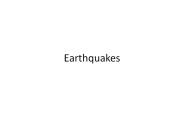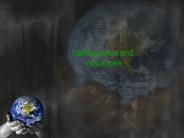Earthquakes PowerPoint PPT Presentations
All Time
Recommended
earthquakes features of earthquakes write a paragraph about earthquakes using the following vocabulary words. underline each vocabulary term as you use it.
| PowerPoint PPT presentation | free to download
Earthquakes and Volcanoes Earthquakes An earthquake is the shaking and trembling that results from the sudden movement of part of the Earth s crust.
| PowerPoint PPT presentation | free to view
Sorting out cards into a set of volcano features and a set of earthquake features ... An earthquake explodes ash and lava into the air ...
| PowerPoint PPT presentation | free to view
A is someone who studies earthquakes. ... Video: Earthquakes ... San Francisco (California, USA) Tokyo (Japan) Kobe (Japan) India (India) ...
| PowerPoint PPT presentation | free to view
Title: EARTHQUAKES Author: Teacher Last modified by: teacher Created Date: 3/22/2004 8:54:41 PM Document presentation format: On-screen Show (4:3) Company
| PowerPoint PPT presentation | free to download
Earthquakes * Earthquakes What is an Earthquake? Rapid release of energy along a fracture in the Earth s crust Sudden movement releases energy Rocks deform (bend ...
| PowerPoint PPT presentation | free to download
Earthquakes Earthquakes Earthquakes are natural vibrations of the ground, caused by: Fractures in earth s crust Volcanic eruptions Stress and Strain Stress causes ...
| PowerPoint PPT presentation | free to view
Earthquakes! **Adapted from www.middleschoolscience.com What is an earthquake? Used to describe both sudden slip on a fault, and the resulting ground shaking and ...
| PowerPoint PPT presentation | free to view
Earthquakes Section 17.2 Earthquakes Shaking of the Earth s crust caused by a release of energy Build-up of stress Stress overcomes friction Plates slip (EQ) Land ...
| PowerPoint PPT presentation | free to download
Stress is a force that acts on rock to change its volume or ... parts of the earths surface where ... the surface A lot of earthquakes begin ...
| PowerPoint PPT presentation | free to download
Earthquakes & Society Objectives Discuss factors that affect the amount of damage done by an earthquake. Some Earthquake Hazards The damage produced by an earthquake ...
| PowerPoint PPT presentation | free to view
Earthquakes What are Earthquakes? The shaking or trembling caused by the sudden release of energy Usually associated with faulting or breaking of rocks Continuing ...
| PowerPoint PPT presentation | free to download
San Francisco's famous earthquake of 1906. Quake caused damage to some buildings. ... Earthquake definition and causes provided (as noted) by World Book Online. ...
| PowerPoint PPT presentation | free to view
Why do Earthquakes Occur ? ... Sudden slip causes earthquakes. ... Lithosphere brittle part of earth earthquakes happen here ...
| PowerPoint PPT presentation | free to download
Earthquakes What is an Earthquake? The shaking and trembling that results from the movement of rocks in the Earth s crust. What does the plate movement create?
| PowerPoint PPT presentation | free to view
Chapter 8 Earthquakes and the Earth s Interior Introduction Earthquake the sudden release of energy, usually along a fault, that produces shaking or trembling ...
| PowerPoint PPT presentation | free to view
Earthquakes What is an Earthquake? Earthquake the vibration of Earth produced by the rapid release of energy Most often caused by slippage along a fault in Earth ...
| PowerPoint PPT presentation | free to download
Exploring Earthquakes By: Dylan & Ian
| PowerPoint PPT presentation | free to view
Monitoring Earthquakes Chapter 6 Section 3 Seismograph An instrument that measures the vibrations from an earthquake A seismogram is the recording of the vibrations ...
| PowerPoint PPT presentation | free to download
... seismological information for planning and design purposes is an important factor ... old structures and build new earthquake-resistant ...
| PowerPoint PPT presentation | free to view
Earthquakes Happening Created by Emily Bruch and Tia Green Alfred Wegener s Theory Alfred Wegener had a thought that there is a super continent .
| PowerPoint PPT presentation | free to view
Earthquakes. While going over the notes, answer the following questions. ... Idaho is part of many different fault systems and has many earthquakes per year. ...
| PowerPoint PPT presentation | free to view
Earthquakes An Earthquake is the sudden movement of the earth It is caused by the abrupt release of strain that has accumulated over a long time Earthquakes in ...
| PowerPoint PPT presentation | free to view
Seismology study of earthquakes Seismogram the record of an earthquake Seismograph instrument used to record earthquakes (creates seismograms) ...
| PowerPoint PPT presentation | free to view
Measuring Earthquakes Ch. 2 Section 2 Measuring Earthquakes Every day there are about 8,000 earthquakes. Most too small to notice After an earthquake the two most ...
| PowerPoint PPT presentation | free to download
An earthquake is The vibration of the earth caused by the sudden motion of tectonic plates Energy is transferred through the ground from the origin outward in a ...
| PowerPoint PPT presentation | free to view
Seismometer sensitive instrument that detects and records seismic waves. Seismogram record produced by a seismometer. Earthquakes. Travel-time curves ...
| PowerPoint PPT presentation | free to view
Earthquakes-Pt.2 Earthquake Processes (mechanisms/causes) Effects of earthquakes (damage) Earthquake risk and prediction Responses to earthquake hazards
| PowerPoint PPT presentation | free to download
USGS Earthquake Hazards Program Earthquakes 101 (EQ101) Lisa Wald and Penelope Nichols USGS Pasadena Madrona K-8 U.S. Department of the Interior
| PowerPoint PPT presentation | free to download
Lecture 16 Earthquakes What are earthquakes? Elastic rebound theory Waves generated by earthquakes: P waves, S waves, Surface waves Locating earthquakes
| PowerPoint PPT presentation | free to view
EARTHQUAKES AND EARTH S INTERIOR Core Innermost layer, where the magnetic field is generated and much geothermal energy resides Separated into outer core (liquid ...
| PowerPoint PPT presentation | free to view
Which best describes earthquake hazard in PA? a) earthquakes ... Require a seismograph. One magnitude per earthquake ... Seismograph. rotating. drum ...
| PowerPoint PPT presentation | free to view
Earthquakes. MEASURING EARTHQUAKES. Seismograph. records the intensity, direction, ... Seismograph of a magnitude. 9.5 earthquake. RICHTER SCALE ...
| PowerPoint PPT presentation | free to view
Chapter 11 Earthquakes What is an earthquake An earthquake is the vibration of Earth produced by the rapid release of energy Energy released radiates in all ...
| PowerPoint PPT presentation | free to download
... rocks moving horizontally past each other EARTHQUAKES Earthquake Waves ... a high-speed flow of very hot gases and dust VOLCANOES Effects of ...
| PowerPoint PPT presentation | free to download
What are earthquakes? Words to know Earthquake Focus Epicenter Seismic Wave Facts Most earthquakes occur along faults (where two plates touch) when ...
| PowerPoint PPT presentation | free to view
Sylmar Earthquake About: When: ... or soil failure due to earthquakes. ... The building is separated from the actual foundation.
| PowerPoint PPT presentation | free to download
Features of Earthquakes (45) Seismic waves generated by an earthquake travel through Earth. Ground moves forward and backward, up and down, and shifts from side to side.
| PowerPoint PPT presentation | free to download
(www.ks5u.com) Question? What strange things happened before the earthquake? The animals were too nervous to eat Mice ...
| PowerPoint PPT presentation | free to download
Earthquakes are produced by the rapid release of elastic energy stored in rock ... Locating Earthquakes ... Earthquakes occur in narrow zones marking the ...
| PowerPoint PPT presentation | free to download
earthquake: a trembling or shaking of the ground caused by the sudden release of ... Measuring Earthquakes ... World Distribution of Earthquakes ...
| PowerPoint PPT presentation | free to view
Earthquakes and Seismic Waves Earthquakes and Seismic Waves Earthquake: Shaking and trembling that results from the movement of rock beneath Earth s surface.
| PowerPoint PPT presentation | free to view
Earthquakes and Volcanoes Seismic Hazards Ring of Fire Ring of Fire Earthquakes and volcanoes are not distributed randomly- they occur in specific regions- usually ...
| PowerPoint PPT presentation | free to download
Earthquakes. Standard 3d. Students know why and how earthquakes occur and the scales used to measure their ... Earthquakes. What causes Earthquakes? ...
| PowerPoint PPT presentation | free to view
Unit 5: Earthquakes January 4th/5th Objective: Intro to Earthquakes Agenda: New seating chart Warm-up/review plate boundaries Killer Quake video and questions Warm-up ...
| PowerPoint PPT presentation | free to view
Richter scale. Earthquake energy. Seismograms can be used to find ... The Richter Scale. M=1 to 3: Recorded on local seismographs, but generally not felt ...
| PowerPoint PPT presentation | free to view
Rock on either side of a fault or a crack that mark plate boundaries becomes ... The energy released by an earthquake is measured by a seismograph. ...
| PowerPoint PPT presentation | free to view
... Earthquake was from a deep focus Earthquake epicentered near Acapulco, Mexico. Acapulco was spared; Mexico City was not. Why? Amplification. Mexico City, 1985 ...
| PowerPoint PPT presentation | free to view
Most earthquakes occur along tectonic plate boundaries and are often associated with volcanism ... Seismology: the study of earthquakes ...
| PowerPoint PPT presentation | free to view
What are Earthquakes? The shaking or trembling caused by the sudden release of energy ... 80% of all earthquakes occur in the circum-Pacific belt ...
| PowerPoint PPT presentation | free to download
Seismic waves are waves of energy released during an earthquake. ... scientists today more often use other scales, such as the moment-magnitude scale.
| PowerPoint PPT presentation | free to download
Unit 6 Earthquakes and Volcanoes
| PowerPoint PPT presentation | free to download
Earthquakes! ... The 1964 Alaska earthquake remains the strongest on record in ... 1997: Large earthquake on the Anatolian Fault causes substantial damage to ...
| PowerPoint PPT presentation | free to view
Earthquakes Plate movements cause large forces The rock breaks, and this break can sometimes be tens of kilometers long Faults are fractures in the Earth s surface ...
| PowerPoint PPT presentation | free to view
Earthquakes in Vrancea
| PowerPoint PPT presentation | free to download
Used for emergency preparedness, response, and recovery planning. Works with GIS software to display graphical maps of earthquake hazards and potential damage ...
| PowerPoint PPT presentation | free to view
























































